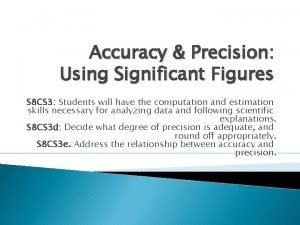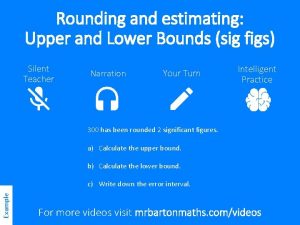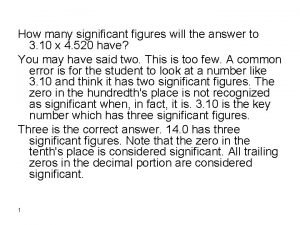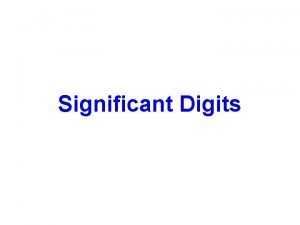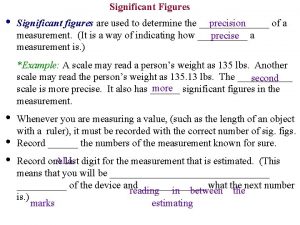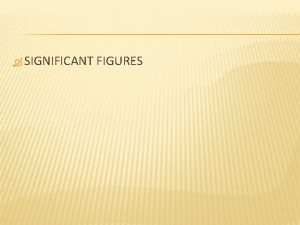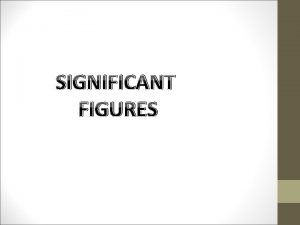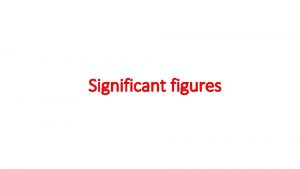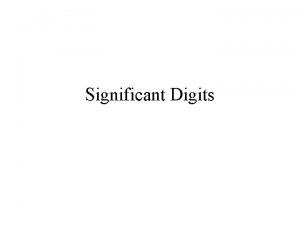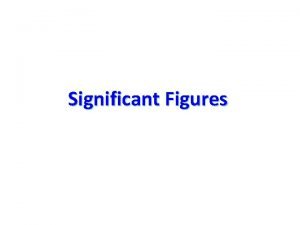Significant Figures precision Significant figures are used to







- Slides: 7

Significant Figures • precision Significant figures are used to determine the _______ of a measurement. (It is a way of indicating how _____ precise a measurement is. ) *Example: A scale may read a person’s weight as 135 lbs. Another scale may read the person’s weight as 135. 13 lbs. The ______ second more significant figures in the scale is more precise. It also has ______ measurement. • • • Whenever you are measuring a value, (such as the length of an object with a ruler), it must be recorded with the correct number of sig. figs. Record ______ the numbers of the measurement known for sure. ALL Record one last digit for the measurement that is estimated. (This means that you will be ________________ of the device and _______ what the next number reading in between the is. ) marks estimating

Significant Figures • Practice Problems: What is the length recorded to the correct number of significant figures? length = ____cm 11. 65 (cm) 10 20 30 40 length = ____cm 58 50 60 70 80 90 100

Rules for Counting Significant Figures in a Measurement • When you are given a measurement, you will need to be aware of how many sig. figs. the value contains. Here is how you count the number of sig. figs. in a given measurement: #1 (Non-Zero Rule): All digits 1 -9 are significant. 3 *Examples: 2. 35 g =_____S. F. 2 S. F. 2200 g = _____ #2 (Straddle Rule): Zeros between two sig. figs. are significant. 3 4 *Examples: 205 m =_____S. F. 80. 04 m =_____S. F. 5 7070700 cm =_____S. F. #3 (Righty-Righty Rule): Zeros to the right of a decimal point AND anywhere to the right of a sig. fig. are significant. 3 3 *Examples: 2. 30 sec. =_____S. F. 20. 0 sec. =_____S. F. 4 0. 003060 km =_____S. F.

Rules for Counting Significant Figures in a Measurement #4 (Bar Rule): Any zeros that have a bar placed over them are sig. (This will only be used for zeros that are not already significant because of Rules 2 & 3. ) 4 *Examples: 3, 000 m/s =_____S. F. 2 20 lbs =____S. F. #5 (Counting Rule or Exact #’s): Any time the measurement is determined by simply counting the number of objects, the value has an infinite number of sig. figs. (This also includes any conversion factor known exactly without it being rounded off for ease of use!) *Examples: 15 students =_____S. F. 29 pencils = ____S. F. ∞ 7 days/week =____S. F. ∞ ∞ 60 sec/min =____S. F. ∞ 1 inch = exactly 2. 54 cm. . . The measurement “ 2. 54 cm” has ____ S. F. ∞

• Scientific Notation Scientific notation is a way of representing really large or small numbers using powers of 10. *Examples: 5, 203, 000, 000 miles = 5. 203 x 1012 miles 0. 000 042 mm = 4. 2 x 10− 8 mm Steps for Writing Numbers in Scientific Notation (1) Write down all the sig. figs. (2) Put the decimal point between the first and second digit. (3) Write “x 10” (4) Count how many places the decimal point has moved from its original location. This will be the exponent. . . either + or −. + and if the (5) If the original # was greater than 1, the exponent is (__), original # was less than 1, the exponent is (__). . (In other words, large − numbers have (__) + exponents, and small numbers have (__) − exponents.

Scientific Notation • Practice Problems: Write the following measurements in scientific notation or back to their expanded form. 477, 000 miles = ________miles 4. 77 x 108 0. 000 910 m = _________ m 9. 10 x 10− 4 − 9 6, 300, 000 6. 30 x 10 miles = __________ miles 0. 00000388 3. 88 x 10− 6 kg = _________ kg

Calculations Using Sig. Figs. • When adding or subtracting measurements, all answers are to be rounded off to the least # of ______ found in decimal _____ places the original measurements. Example: + ≈ 157. 17 • (only keep 2 decimal places) When multiplying or dividing measurements, all answers are to be significant_____ figures found in the rounded off to the least # of _____ original measurements. Practice Problems: (only keep 1 decimal place) 4. 7 cm 2. 83 cm + 4. 009 cm − 2. 1 cm = 4. 739 cm ≈_____ 98 m 2 36. 4 m x 2. 7 m = 98. 28 m 2 ≈ _____ (only keep 2 sig. figs) 5. 9 g/m. L 0. 52 g ÷ 0. 00888 m. L = 5. 855855 g/m. L ≈ ____ (only keep 2 sig. figs)

